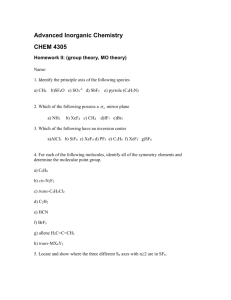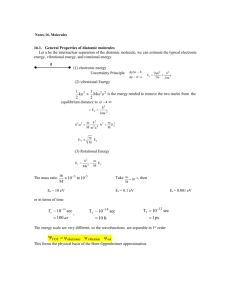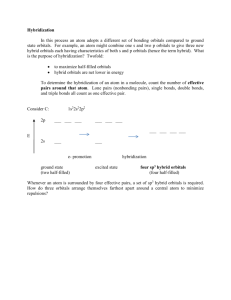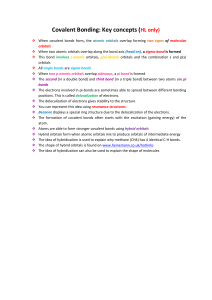Two Equivalent eg Orbitals for the Discussion of Bonding in
advertisement
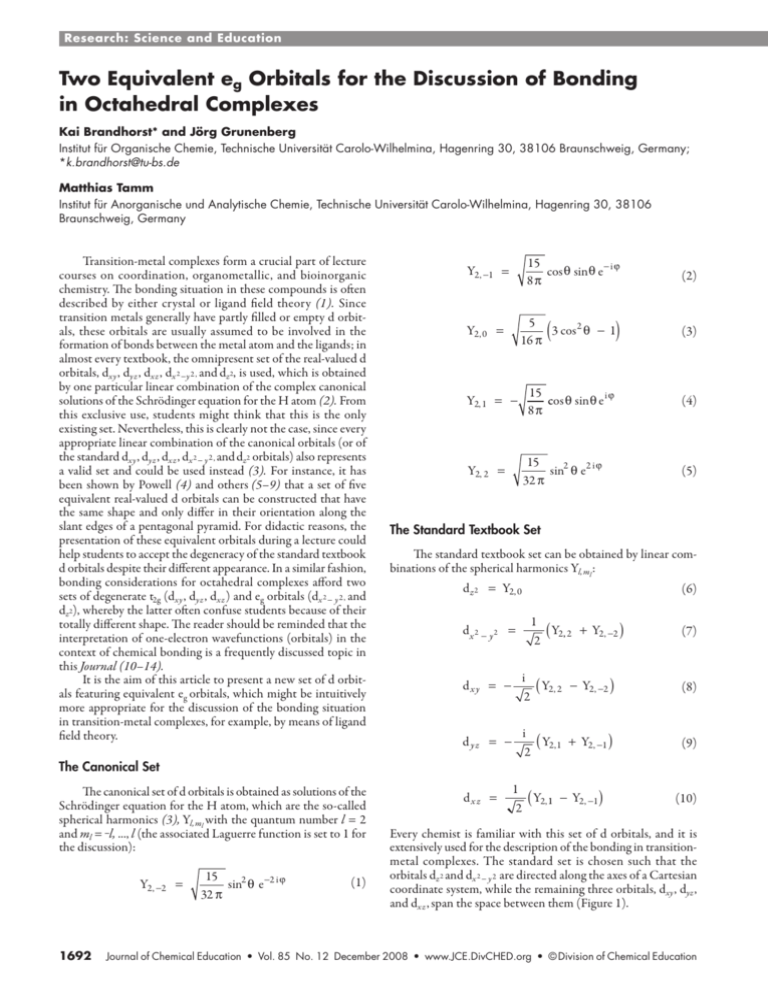
Research: Science and Education Two Equivalent eg Orbitals for the Discussion of Bonding in Octahedral Complexes Kai Brandhorst* and Jörg Grunenberg Institut für Organische Chemie, Technische Universität Carolo-Wilhelmina, Hagenring 30, 38106 Braunschweig, Germany; *k.brandhorst@tu-bs.de Matthias Tamm Institut für Anorganische und Analytische Chemie, Technische Universität Carolo-Wilhelmina, Hagenring 30, 38106 Braunschweig, Germany Transition-metal complexes form a crucial part of lecture courses on coordination, organometallic, and bioinorganic chemistry. The bonding situation in these compounds is often described by either crystal or ligand field theory (1). Since transition metals generally have partly filled or empty d orbitals, these orbitals are usually assumed to be involved in the formation of bonds between the metal atom and the ligands; in almost every textbook, the omnipresent set of the real-valued d orbitals, dxy , dyz , dxz , dx 2 −y 2 , and dz2, is used, which is obtained by one particular linear combination of the complex canonical solutions of the Schrödinger equation for the H atom (2). From this exclusive use, students might think that this is the only existing set. Nevertheless, this is clearly not the case, since every appropriate linear combination of the canonical orbitals (or of the standard dxy , dyz , dxz , dx 2 − y 2 , and dz2 orbitals) also represents a valid set and could be used instead (3). For instance, it has been shown by Powell (4) and others (5–9) that a set of five equivalent real-valued d orbitals can be constructed that have the same shape and only differ in their orientation along the slant edges of a pentagonal pyramid. For didactic reasons, the presentation of these equivalent orbitals during a lecture could help students to accept the degeneracy of the standard textbook d orbitals despite their different appearance. In a similar fashion, bonding considerations for octahedral complexes afford two sets of degenerate t2g (dxy , dyz , dxz ) and eg orbitals (dx 2 − y 2 , and dz2), whereby the latter often confuse students because of their totally different shape. The reader should be reminded that the interpretation of one-electron wavefunctions (orbitals) in the context of chemical bonding is a frequently discussed topic in this Journal (10–14). It is the aim of this article to present a new set of d orbitals featuring equivalent eg orbitals, which might be intuitively more appropriate for the discussion of the bonding situation in transition-metal complexes, for example, by means of ligand field theory. Y2, 1 15 cos R sin R e i K 8Q (2) Y2, 0 5 3 cos 2 R 1 16 Q (3) Y2, 1 15 cos R sin R e i K 8Q (4) Y2, 2 1692 Y2, 2 15 sin2 R e 2 i K 32 Q (1) 15 sin2 R e2 i K 32 Q (5) The Standard Textbook Set The standard textbook set can be obtained by linear combinations of the spherical harmonics Yl, ml : dz2 Y2, 0 dx 2 y 2 dxy d yz dxz The Canonical Set The canonical set of d orbitals is obtained as solutions of the Schrödinger equation for the H atom, which are the so-called spherical harmonics (3), Yl,ml with the quantum number l = 2 and ml = ‒l, ..., l (the associated Laguerre function is set to 1 for the discussion): (6) 1 Y2, 2 Y2, 2 2 (7) i Y2, 2 Y2, 2 2 (8) i 2 Y2,1 Y2, 1 1 Y2, 1 Y2, 1 2 (9) (10) Every chemist is familiar with this set of d orbitals, and it is extensively used for the description of the bonding in transitionmetal complexes. The standard set is chosen such that the orbitals dz 2 and dx 2 − y 2 are directed along the axes of a Cartesian coordinate system, while the remaining three orbitals, dxy , dyz , and dxz , span the space between them (Figure 1). Journal of Chemical Education • Vol. 85 No. 12 December 2008 • www.JCE.DivCHED.org • © Division of Chemical Education Research: Science and Education Table 1. General Set of Coefficients that Satisfy Equations 17–19 a b c d –d (1 – d 2)1/2 (1 – d 2)1/2 d>0 d –(1 – d 2)1/2 d 2)1/2 d>0 d (1 – d 2)1/2 –(1 – d 2)1/2 d>0 –d (1 – d 2)1/2 (1 – d 2)1/2 d<0 –d –(1 – d 2)1/2 –(1 – d 2)1/2 d<0 d (1 – d 2)1/2 d 2)1/2 d<0 d –(1 – d 2)1/2 (1 – d 2)1/2 d<0 –d –(1 – d 2)1/2 –(1 – d 2)1/2 d>0 (1 – –(1 – Figure 1. Standard set of d orbitals. Depicted are the corresponding spherical harmonics. This set allows for any description of bonding by means of ligand field theory; however, if octahedral complexes are discussed, the ligand field splits the degenerate set of d orbitals into two sets of t2g and eg symmetry, respectively. The t2g set consists of the dxy , dyz , and dxz orbitals and these are all of the same shape. In contrast, this is not the case for the eg orbitals, dz 2 and dx 2 − y 2 , which exhibit a totally different shape but are still energetically degenerate. This is somewhat counterintuitive, and the question arises whether a set of equivalent and equally shaped eg orbitals exists, while the t2g orbitals remain unchanged. The New Set eg2 dx y dx z d yz a b c d 0 0 0 0 0 0 0 0 0 0 1 0 0 0 1 0 0 0 0 0 1 2Q Q ± ± e g e g sinR dR dK 1 0 0 2Q Q 1 0 0 2Q Q ±± 0 0 2 0 0 a 2 dz 2 dz 2 d xy (11) d xz d yz (15) 2 a b dz 2 dx 2 y 2 0 1 2 d x 2 y 2 dx 2 y 2 (16) 1 2 sinR dR dK 0 (13) (14) a 2 b 2 1 (17) Simplifying eqs 13 and 14 results in (12) 1 2 b dx 2 y 2 sinR dR dK 1 1 dx 2 y 2 1 e g 2 e g 2 sinR dR dK ± ± a dz dz 2 1 ± ± eg eg 2Q Q b where a–d are constants to be determined. In addition, the new eg orbitals must be orthogonal and normalized, which means that the following conditions have to be fulfilled: The new set can be obtained by the transformation e g1 By noticing that the standard set of d orbitals is already orthonormal, this set of equations can be simplified, as is shown in detail for eq 12: ac bd 0 (18) (19) c 2 d 2 1 Equations 17–19 contains four unknowns, which requires a fourth condition for its unique solution. Eight solutions that depend on the coefficient d can be obtained, which are listed in Table 1. The requirement for a specific sign of the coefficient d stems from the orthogonality condition (cf. eq 18). From eq 18 it is obvious that exactly one of the coefficients a, b, c, or d must differ in sign from the others. That means that the eg1 orbital is constructed formally by adding the dz 2 orbital to the dx 2 − y 2 orbital, while the eg2 orbital is obtained by subtracting dz 2 from dx 2 − y 2. A more concise formulation of this requirement is e g1 dz2 cos M dx 2 y 2 sin M (20) e g 2 dz2 sin M dx 2 y 2 cos M (21) © Division of Chemical Education • www.JCE.DivCHED.org • Vol. 85 No. 12 December 2008 • Journal of Chemical Education 1693 Research: Science and Education Table 2. All Possible Coefficients for the Generation of Two eg Orbitals of the Same Shape a b c d –(1/2)1/2 (1/2)1/2 (1/2)1/2 (1/2)1/2 (1/2)1/2 –(1/2)1/2 (1/2)1/2 (1/2)1/2 (1/2)1/2 (1/2)1/2 –(1/2)1/2 (1/2)1/2 (1/2)1/2 (1/2)1/2 (1/2)1/2 –(1/2)1/2 (1/2)1/2 –(1/2)1/2 –(1/2)1/2 –(1/2)1/2 –(1/2)1/2 (1/2)1/2 –(1/2)1/2 –(1/2)1/2 –(1/2)1/2 –(1/2)1/2 (1/2)1/2 –(1/2)1/2 –(1/2)1/2 –(1/2)1/2 –(1/2)1/2 (1/2)1/2 Figure 2. New set of d orbitals with modified eg orbitals. Depicted are the corresponding spherical harmonies. Since we wish to find a set of eg orbitals where both orbitals should have the same shape, the coefficient d (or λ, respectively) has to be chosen such, that this condition is fulfilled. Because of the D∞ h symmetry of the dz 2 orbital and the shape of the dx 2 − y 2 orbital, the addition and subtraction of the dz 2 orbital to and from the dx 2 − y 2 orbital will result in two eg orbitals with either a bigger positive or negative lobe along the x and y axis, respectively. However, for both eg orbitals to be equally shaped it is necessary that these lobes are equivalent. This is only satisfied if the dz 2 contribution to either of the eg orbitals is the same. From this requirement one can infer that |a| = |c| (or cos λ = sin λ). That means |d| = |(1 − d 2)1/2| (cf. Table 1). This equation has the two solutions d = ±(1/2)1/2, of which only one fulfils the orthogonality condition. Therefore there are eight possible sets of coefficients a, b, c, and d satisfying eqs 17–19 that result in a pair of equally shaped eg orbitals. These are listed in Table 2. Apart from sign, all eight sets of coefficients lead to only one set of eg orbitals, which is given by (here the coefficients of the first row in Table 2 have been used) e g1 A cos 2 R 1 1 eg 2 B A B A cos R 1 1 A 2 A B x r sin R cos K (26) y r sin R sin K (27) z r cosR (28) Substitution into the eg orbital expressions (eqs 22 and 23) leads to 2 cos 2 R (22) e g1 10 8 Qr 2 3 1 x2 3 1 y 2 2 z 2 (29) 3 1 x2 3 1 y 2 2 z 2 (30) 2 2 cos R (23) eg 2 5 32 Q (24) 15 cos 2 K 32 Q (25) The new set of orbitals is depicted in Figure 2. The new eg orbitals exhibit D2h symmetry and have their greatest extension along the x and y axis, respectively, whereas the extension along the z axis is the same for both orbitals. In accordance 1694 with the usual interpretation in terms of crystal field theory for octahedral complexes, six ligands oriented along the Cartesian axes split the degenerate set into two sets, whereby the energy of the eg orbitals is higher than that of the t2g set. But whereas the degeneracy within the eg set is not very intuitive if the textbook orbitals dz 2 and dx 2 − y 2 are considered, the degeneracy of the newly derived eg orbitals is obvious owing to their identical spatial appearance. To suggest an appropriate nomenclature for the new eg orbitals, we express the two orbitals in terms of Cartesian coordinates. The relation between spherical and Cartesian coordinates is given by 10 8 Q r2 Therefore, the two eg orbitals may be denoted dx 2 − y 2 − z 2 and dx 2 − y 2 + z 2, respectively. This notation can also be derived from the transformation (eq 11) after substitution of the coefficients a, b, c, and d (Table 2), resulting in e g1 1 2 d x 2 y 2 dz2 (31) eg 2 1 2 d x 2 y 2 dz 2 (32) Journal of Chemical Education • Vol. 85 No. 12 December 2008 • www.JCE.DivCHED.org • © Division of Chemical Education Research: Science and Education which clearly show that the orbitals dx 2 − y 2 − z 2 and dx 2 − y 2 + z 2 represent the simplest normalized linear combination of the standard eg orbitals dz 2 and dx 2 − y 2. Literature Cited 1. Bethe, H. Ann. Phys. 1929, 3, 133–208. van Vleck, J. H. J. Chem. Phys. 1935, 3, 803–806. For a general review, see Ballhausen, C. J. Introduction to Ligand Field Theory, 1st ed.; McGraw-Hill: New York, 1962. 2. Schrödinger, E. Ann. Phys. 1926, 384, 361–376. Schrödinger, E. Ann. Phys. 1926, 384, 489–527. Schrödinger, E. Ann. Phys. 1926, 385, 437–490. Schrödinger, E. Ann. Phys. 1926, 386, 109–139. 3. Atkins, P. W.; Friedman, R. S. Molecular Quantum Mechanics, 3rd ed.; Oxford University Press: Oxford, 1997. 4. Powell, R. E. J. Chem. Educ. 1968, 45, 45–47. 5. David, C. W. J. Chem. Educ. 1995, 72, A238–A239. 6. Pauling, L.; McClure, V. J. Chem. Educ. 1970, 47, 15–17. 7. Gerloff, M.; Ady, E.; Brinckmann, J. Mol. Phys. 1973, 26, 561–570. 8. Keaveby, I. T.; Pauling, L. Israel J. Chem. 1972, 10, 211–220. 9. Mulder, J. J. C. J. Chem. Educ. 1985, 62, 376–378. 10. Scerri, E. R. J. Chem. Educ. 2002, 79, 310. 11. Spence, J. C. H.; O’Keeffe, M.; Zuo, J. M. J. Chem. Educ. 2001, 78, 877. 12. Scerri, E. R. J. Chem. Educ. 2000, 77, 1492–1494. 13. Simons, J. J. Chem. Educ. 1991, 68, 131–132. 14. Ogilvie, J. F. J. Chem. Educ. 1990, 67, 280–289. Supporting JCE Online Material http://www.jce.divched.org/Journal/Issues/2008/Dec/abs1692.html Abstract and keywords Full text (PDF) Links to cited JCE articles Color figures © Division of Chemical Education • www.JCE.DivCHED.org • Vol. 85 No. 12 December 2008 • Journal of Chemical Education 1695



